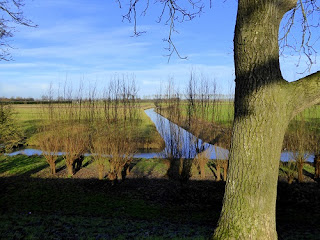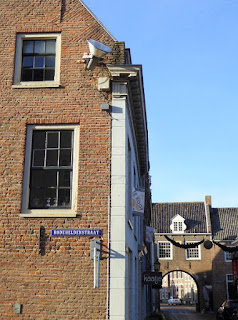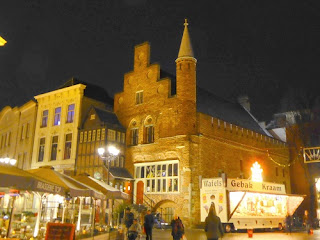Friday, 13 January 2017
One fine day in Buren and Den Bosch
It was the only fine day of our happy time based with friends in Amsterdam, with the possible exception of the finale, a mix of dazzling blue skies, heavy showers and the occasional rainbow. Grey and bitter cold didn't stop us excurting elsewhere, to Delft, Gouda and Utrecht, and each place had its special qualities. But the bright-light memories will be of Nick and Max driving us to an exquisite place in the country and strolling around it with us at leisure before depositing us at a train station so we could go on to 's-Hertogenbosch, lively capital of North Brabant (pronounced 'Bos', which was news to me since I'd always sounded the 'sch' for the town's eponymous artist. 'Bosch' means 'woods', as in 'bosky', and 'Hertog' is close to 'Herzog', Duke. Henry I established a hunting lodge here in the 13th century).
My very patchy Rough Guide doesn't even mention Buren, which is good in a way since in busier times it would keep fellow tourists away. The Italians have discovered it, though, and they always have good taste over what's worth seeing, spoilt as they are with 20 per cent of the world's cultural heritage (don't ask me how that figure was arrived at). By the same token Brits don't tend to visit Bamberg, Germany's most stunning city/town (that I've seen, at any rate), while it's a major stopping-point for Italians.
I can track little down about this heavenly place, the epitome of Dutch civic life frozen in time, following the usual boundaries of rivers or streams and in this case a superb set of walls/ramparts which you can walk around in half an hour, and with the church bang in the centre. The two added tower storeys give a clue as to the distinction accorded this tiny place: the lower brick storey was added to the late Gothic building in 1540 by Alessandro Pasqualini, while its Renaissance look is surmounted by a Classical crown (1661-2, from designs by Pieter Post).
In short, royal status was accorded the town by William of Orange - more on him in the Delft instalment to come -when he married Anna of Egmont, Countess of Buren.
Their daughter, Marie von Nassau, bequeathed the town its grandest building, an orphanage if you can believe it, founded in 1613. It's now a by all accounts rather fine Museum of the Military Police. not that I think I would have been tempted, inviting though the gateway unquestionably is.
The question was in any case academic because on 2 January nearly everything was closed, the church included, and only the stray small group of visitors was to be seen around town or circumventing it.
This is the beautiful stretch beyond the splendid windmill, appropriately known as William of Orange and also of some antiquity (1716).
This area is the orchard of the Netherlands as Kent is the garden of England; Nick and Max's friend the wonderful artist Peter Keizer has spent a lot of time around here studying the fruit blossoms which he translates into thickly applied oil paintings. Obviously this photo is the one that's not mine.
But there's something remarkable, too, about seeing the bare outlines of trees near and far, especially poplars planted in straight lines.
I'd loved to have strolled down into the lanes that radiate outwards from the town, but there was only time to look longingly across at the market gardens
as well as towards the town from the south-east,
down to the gate through which we'd entered and exited several times already
and along to the wooden houses and barns leading out to the north west
before we gathered to get warm in a craft shop, one of the two establishments that seemed to be open, for excellent coffee and the best apple pie I've ever tasted. Li'l Johnny was alert to the smells but he's not a greedy dog so he sat patiently and stared longingly.
Train connections were swift: we just turned up at a nearby station and were in Den Bosch half an hour later. Like other city stations which were our starting points, this one meant a short walk down to the river or canal with the walled city beyond, but unlike the others it has a splendid monument of 1901 symbolising the city's reputation as "The Dragon of the Marshes", unconquered for centuries.
Not sure what they call the form of grandiose late Victorian architecture on this side of the River Dieze, as well as around the Concertgebouw in Amsterdam, but I have a sneaking fondness for it. Little of that once over the river and heading towards the cathedral,
but there are fine and various facades along the Hinthamerstraat - this chemist's,
a former cinema
and the awning of the most tempting patisserie, paying homage of course to the city's most famous son. Wish I'd come to the big 500th anniversary exhibition here last year.
No time to loiter for any refreshment since we wanted to catch the interior of St John's (Jan's) Cathedral with the late afternoon light on it. This is one of the glories of northern Gothic built over a very long period of time (1380-1540) which shows in the difference between the west tower and the rest.
Inside, the impression is somewhat diminished by the Victorian overlay and the gaudy glass which disfigures so many Dutch religious buildings either rebuilt after fires or smashed up in anti-Catholic frenzies. The Protestants didn't use it much after 1629, when it fell into near-dereliction until Napoleon restored it to the Catholics in 1810. It now has a status as a Dutch Kanjermonument (literally 'whopper-monument') which qualifies it for government support. Despite the overlay, the grandeur within remains impressive both looking east
and back to the huge 17th century organ case.
Sunlight was still dappling reflections of the glass onto the pillars
and the central tower, replacement for a much grander version which collapsed in a fire in 1584, is filled with light
which made the all-seeing eye the more impressive.
Catholic sway places great emphasis on the 13th century Madonna and Child in the Lady Chapel (unusually by the west entrance) known as Zoete Liewe Vrouw ('Sweet Dear Lady').
On 2 January, with the streets outside thronged with shoppers, it was a popular destination for families bringing the children to light candles.
St Jan's must also have boasted the most impressive nativity walkabout around the east-end ambulatory, taxidermal heaven or hell with beasts from all continents
leading towards the crib scene at the end.
The only one I've seen to cap this is the hilarious one in Ienne, Italy, a hill town with dressed-up mannequins posted at many street corners and a manger with real sheep. Here a stuffed cat has to suffice.
I could have spent hours looking at the detail on the exterior, especially around the monumental south door
but hunger gnawed and at sunset, having traipsed a bit around the fair in the square before the cathedral
we headed into the excellent Heart of Brabant right by the cathedral for a fine set lunch of onion soup, two choice sandwiches and a prawn croquette.
Late arrival meant that we missed the opening times of the Zwannenbroederhuis, home to the 'Swan Brotherhood' guild to which Bosch had belonged; it houses, I gather, a fine collection of old instruments and manuscripts.
Den Bosch after dark over the Christmas period is, like many other Dutch towns, a festival of light
with plenty of cosy interiors. Going down the Verwersstraat/Oude Dieze past the splendid 18th century building which was once the seat of the provincial commissioner and now houses the Noordbrabants Museum,
and a modern building opposite with a Bosch mural
there were posh speciality shops going down the Verwersstraat/Oude Dieze, including one specialising in, of all things, leather floors (but its ceiling was more interesting)
as well as several antique shops and/or galleries with manger scenes either old-fashioned
or specially displayed.
It was too dark by now to look out over the nature reserve from the southern bastion, so we wended our way back via the lively triangular market-place with its statue of Bosch, the 16th century town hall behind
and stalls presumably left over from the 500th exhibition promising grotesque earthly delights.
Ours would have been to buy the local extravagance, the Bossche Bol of chocolate and whipped cream, but the main stall beneath De Moriaan, the oldest brick hall (beginning of the 13th century) in the Netherlands, had run out.
All was not lost; the fine baker's near the station packed us up a box of five to take back to our hosts on Amsterdam's Sarphatipark and we headed back for another cosy (gezellig) evening.
Labels:
's-Hertogenbosch,
Bosch,
Buren,
Den Bosch,
Gothic,
Peter Keizer,
St Jan's Cathedral,
William of Orange
Subscribe to:
Post Comments (Atom)




















































4 comments:
Magnificent. I so envy the way you can travel around Europe without the need to cross an ocean first. Your words about how you could have spent hours just looking at that church exterior were it not for getting hungry made me feel better about cutting short a visit to an incredible (really over the top) Baroque church while in Palermo. (Though of course, unlike you, I have no idea usually what I'm looking at or what things are called, but I enjoy it, just the same.)
Well, 'hours' was slightly hyperbolic. But I did want to find the additional (contemporary) sculptures which are supposed to include an angel with a mobile phone, only one number to press on it for direct line to God. Oddly you just remind me of last night's dream, which was about a holiday in which visiting two cathedrals was, we decided, enough. In real life, the number of ecclesiastical buildings I can cram in is never too much.
Of course if your church was the Gesu and you were anxious to find that cannoli shop I would have understood. SO glad you went to Palermo, still my treasure of recent city discoveries, and look forward to hearing more about it.
The Gesu yes. We were transfixed by its over-the-topness. Do I detect from what you write that your reaction was a bit different, that is, one of needing an early escape?
Actually no, we'd 'done' the cannoli bakery earlier, and were to return, but the Gesu didn't do much for me. Think I've mentioned elsewhere that there were two baroque churches I liked better, chiefly for their layered pictures. And there was one at the other end of the Ballaro market which had some of that stuff too, though generally it was in a bit of a state.
Post a Comment